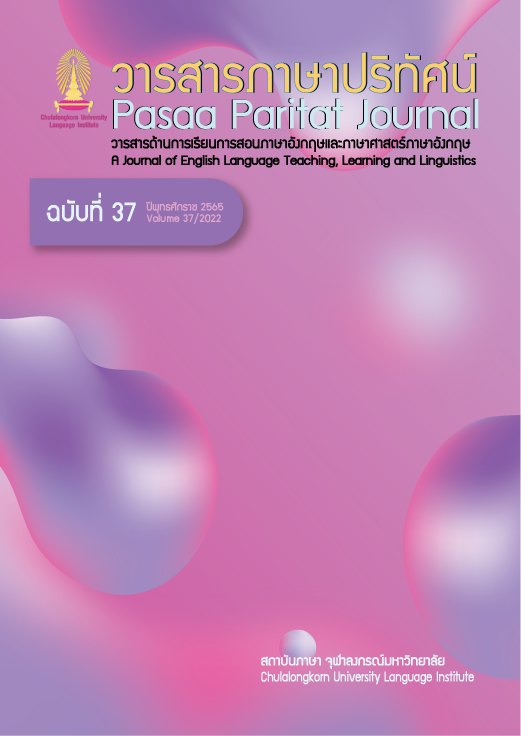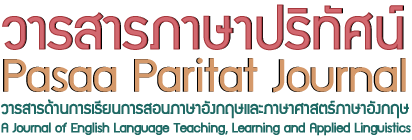Approaches to Assessing Summary Content: Implications for Teaching Material Development and Recommendations for Research
DOI:
https://doi.org/10.58837/CHULA.PPJ.37.4คำสำคัญ:
Summary, Summarisation, Summary writing, Summary content, Academic writing, Integrated writing, Summary assessment, Integrated writing assessmentบทคัดย่อ
Amongst the different aspects of summary writing, summary content is viewed as one of the primary constructs in measuring the quality of summaries (Alderson, 2000; Hijikata et al., 2015; Putri, 2020; Yamanishi et al., 2019). Although summaries have been defined in a variety of ways by researchers (e.g., Chuenchaichon, 2022; Dewi & Saputra, 2021), authors of books and writing handbooks (e.g., Turabian, 2019; Wette, 2020), as well as online writing resources (e.g., Pressbooks, 2022; Purdue University Online Writing Lab, 2022), the one thing that is held constant across these publications is the idea that summaries must capture all the essential information from the source materials. This mutual agreement only suggests that summary content (or the ideas summary writers include in their summarised texts) must be taken into consideration as far as the assessment of summaries is concerned. Given the importance of summary content in assessing summary quality, this article aims to present how summary content has been evaluated and discuss implications for teaching material development and recommendations for research.
เอกสารอ้างอิง
Alderson, J. C. (1996). The testing of reading. In C. Nuttall (Ed.), Teaching reading skills in a foreign language. London: Heinemann.
Alderson, J. C. (2000). Assessing reading. Cambridge: Cambridge University Press.
Alderson, J. C., Clapham, C., & Wall, D. (1995). Language test construction and evaluation. Cambridge University Press.
Baba, K. (2009). Aspects of lexical proficiency in writing summaries in a foreign language. Journal of Second Language Writing, 18, 191–208.
Bacha, N. (2001). Writing evaluation: What can analytic versus holistic essay scoring tell us? System, 29, 371–383. https://doi.org/10.1016/S0346-251X(01)00025-2.
Bachman, L. F. (1990). Fundamental considerations in language testing. Oxford University Press.
Bachman, L. F., & Palmer, A. S. (1996). Language testing in practice: Designing and developing useful language tests. Oxford University Press.
Bachman, L. F., & Palmer A. S. (2010). Language assessment in practice: Developing language assessments and justifying their use in the real world. Oxford University Press.
Brindley, G. (1991). Defining language ability: The criteria for criteria. In S. Anivan (Ed.), Current developments in language testing. SEAMEO Regional Language Centre.
Brown, D. H., & Abeywickrama, P. (2019). Language assessment: Principles and classroom practices. (3rd ed.). Pearson Education ESL.
Brown, A. L., Campione, J. C., & Day, J. D. (1981). Learning to learn: On training students to learn from texts. Educational Researcher, 10, 14–21.
Brown, A. L., & Day, J. D. (1983). Macrorules for summarising texts: The development of expertise. Journal of Verbal Learning and Verbal Behavior, 22, 1–14.
Brown, A. L., Day, J. D., & Jones, R. S. (1983). The development of plans for summarizing texts. Child Development, 54, 968–979.
Brown, A. L., & Smiley, S. S. (1977). Rating the importance of structural units of prose passages: A problem of metacognitive development. Child Development, 48, 1–8.
Carrell, P. L. (1985). Facilitating ESL reading by teaching text structure. TESOL Quarterly, 19(4), 727–752.
เผยแพร่แล้ว
เวอร์ชัน
- 2023-03-20 (3)
- 2023-03-20 (2)
- 2023-02-24 (1)
รูปแบบการอ้างอิง
ฉบับ
ประเภทบทความ
สัญญาอนุญาต

อนุญาตภายใต้เงื่อนไข Creative Commons Attribution-NonCommercial-NoDerivatives 4.0 International License.


